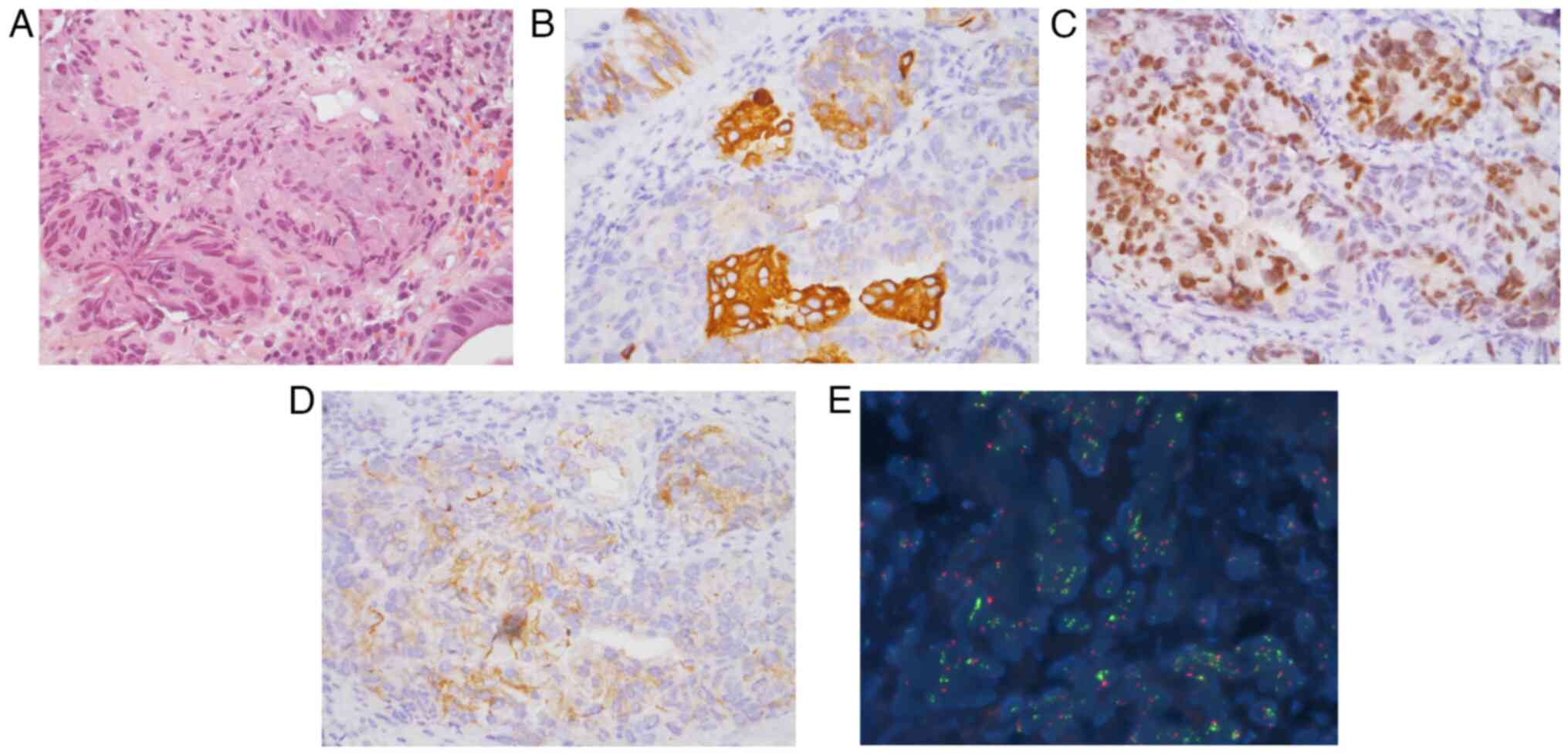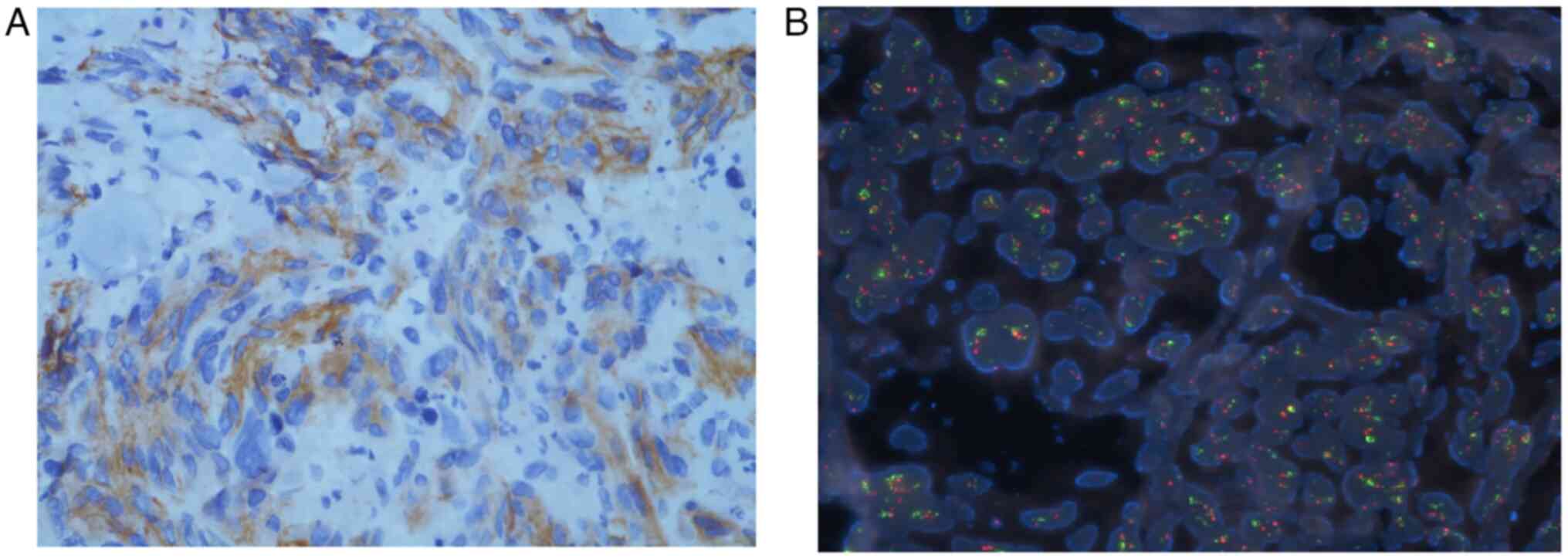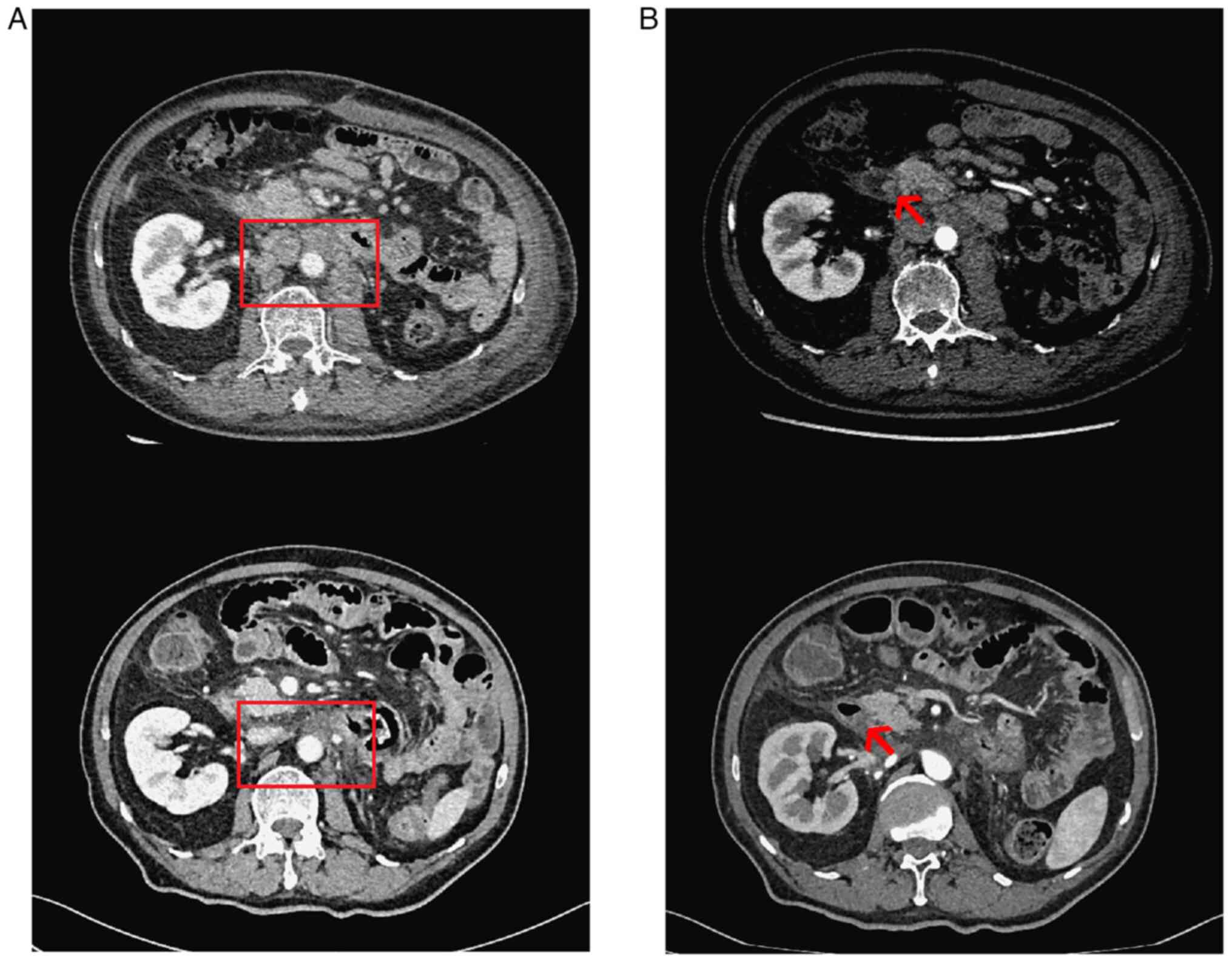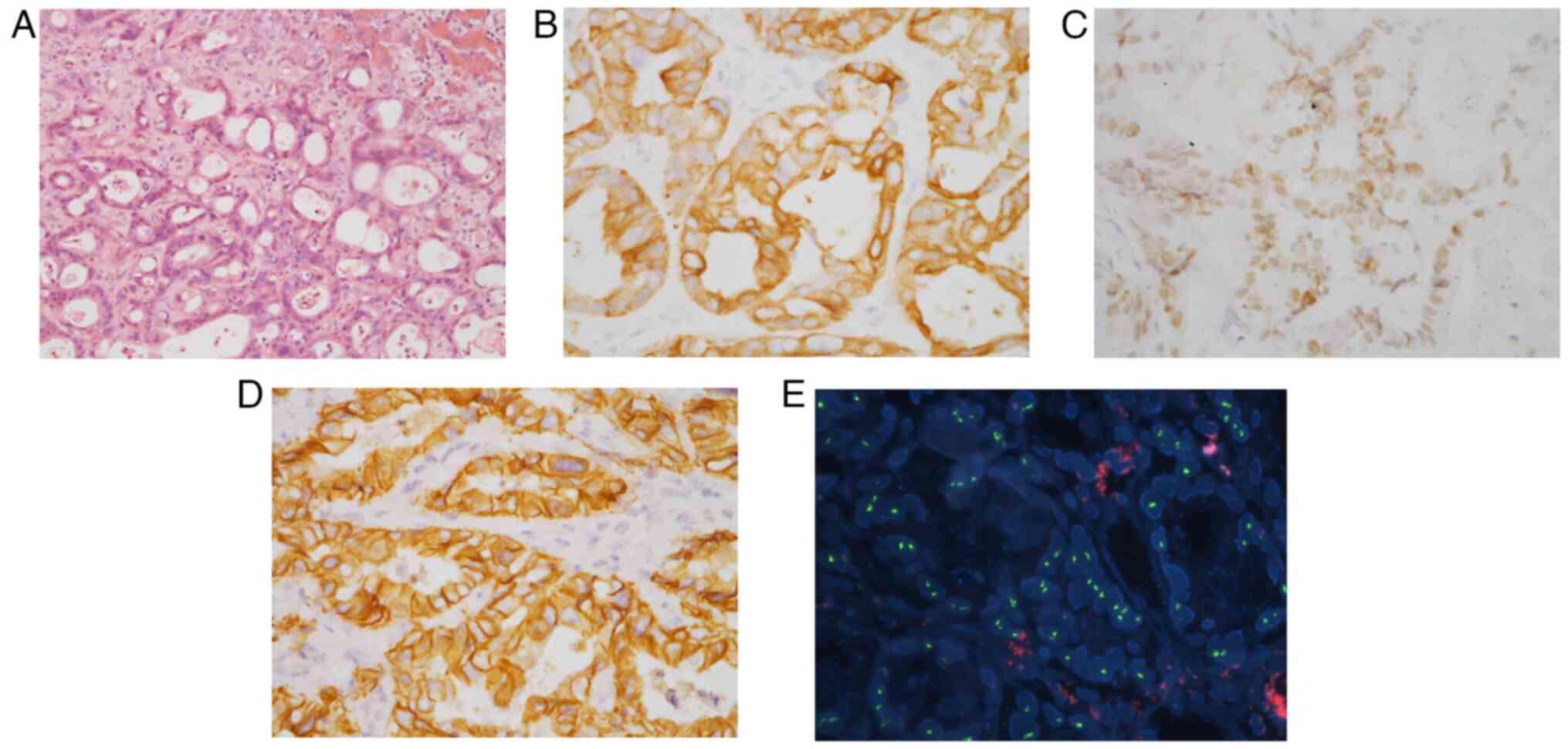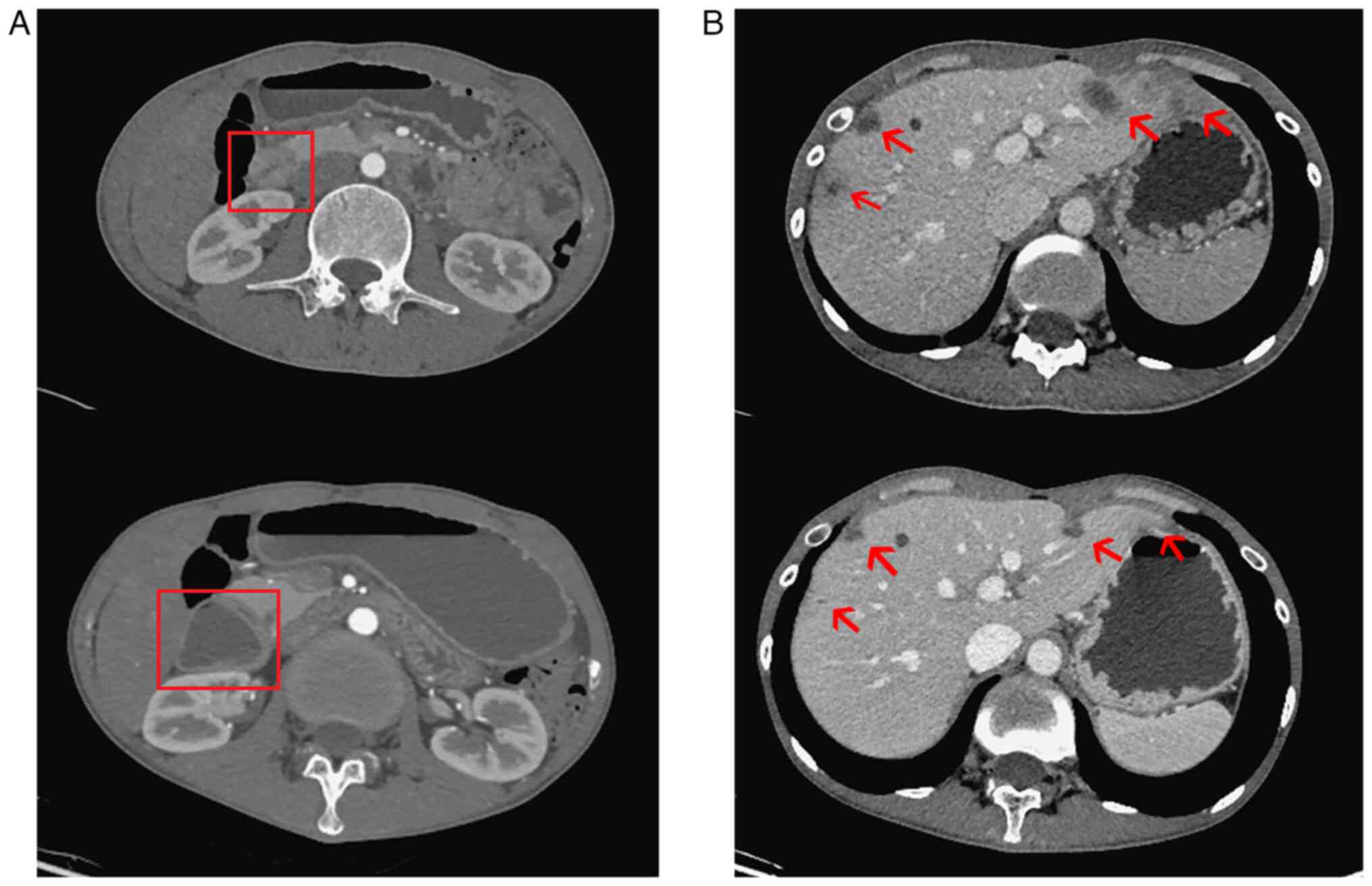Introduction
Small bowel adenocarcinoma (SBA) is a rare disease,
constituting ~2% of gastrointestinal malignancies and 30% of all
small intestinal malignancies (1,2). Owing
to its inconspicuous location and aggressive biological behavior,
patients with SBA are often diagnosed at an advanced stage,
resulting in a prognosis less favorable than that of patients with
colorectal cancer (3). Therapeutic
options are limited for individuals with unresectable or metastatic
SBA. In comparison to best supportive care, palliative chemotherapy
with a fluoropyrimidine-based regimen has been shown to extend the
median overall survival (OS) time by ~10 months (4). However, due to its rarity, prospective
research into targeted therapies for the treatment of SBA is
lacking. A recent prospective analysis of clinical samples from
patients with SBA revealed HER2 amplification mutations in
2.2% of cases (5). Over the past 20
years, HER2-targeted therapies have significantly improved the
prognosis of breast, gastric and colorectal cancer in cases of HER2
overexpression and/or amplification (6). Data from the ToGA trial demonstrated
that, when used in patients with chemotherapy-naive HER2-positive
advanced gastric cancer, chemotherapy plus trastuzumab (an
anti-HER2 monoclonal antibody) significantly increased the overall
response rate (ORR) by 12.8% and extended the median OS time by 2.7
months when compared to chemotherapy alone (7). In the HERACLES trial, patients with
HER2-positive metastatic colorectal cancer refractory to standard
care received dual-targeted therapy with trastuzumab and lapatinib.
The results indicated that the combination therapy was effective,
with an objective response rate of 30%, and was well tolerated
(8). Considering the successful
application of anti-HER2 agents in these digestive system
malignancies, it is suggested that patients with SBA harboring HER2
amplification/overexpression may benefit from the administration of
an anti-HER2 monoclonal antibody. The present study describes two
cases of advanced SBA that harbored HER2 amplification
mutations and in which the patients achieved prolonged survival
times from frontline treatment with anti-HER2 therapy in
combination with chemotherapy.
Case report
Case one
A 75-year-old man presented to Huadong Hospital
Affiliated to Fudan University (Shanghai, China) in August 2019
with swelling and pain in the left leg that had persisted for 1
month. A computed tomography (CT) scan revealed enlarged lymph
nodes in the abdominal cavity and retroperitoneum. Subsequent
positron emission tomography-CT (PET-CT) identified multiple
enlarged lymph nodes in the abdominal cavity and a lesion on the
abdominal wall exhibiting increased 18F-fluorodeoxyglucose
(18F-FDG) metabolism. Gastroscopy indicated mucosal roughness in
the duodenal papillary region. For histological diagnosis, a tissue
biopsy was performed. Sections with a thickness of 4 µm were made
from formalin-fixed paraffin-embedded (FFPE) tissues.
Hematoxylin-and-eosin (H&E)-staining was performed using the
Dako Coverstainer (Dako; Agilent Technologies, Inc.) according to
the manufacturer's instructions. Immunohistochemistry was performed
using the Lumatas Autostaining System, as instructed by the
manufacturer (Lumatas Biosystems). The primary antibodies used were
as follows: Cytokeratin 7 (CK7; 1:100; rat; cat. no. MAB-0828;
clone MX053; Fuzhou Maixin Biotech Co., Ltd.), CK20 (1:100; rat;
cat. no. MAB-0834; clone MX059; Fuzhou Maixin Biotech Co., Ltd.),
caudal type homeobox transcription factor 2 (CDX2; undiluted;
rabbit; cat. no. RMA-0631; clone EPR2764Y; Fuzhou Maixin Biotech
Co., Ltd.), HER2 (rabbit; undiluted; cat. no. Kit-0043; clone
MXR001; Fuzhou Maixin Biotech Co., Ltd.). The pathologist used an
inverted microscope to examine all slides. The lesion was confirmed
as an adenocarcinoma, with the following expression: CK7(+) (data
not shown), CK20(+),CDX-2(+) and HER2(++) (Fig. 1). The pathological diagnosis of the
abdominal wall lesion was metastatic adenocarcinoma with the
following immunohistochemical expression: CK(+) (data not shown)
and HER2(++) (Fig. 2). Furthermore,
fluorescence in situ hybridization (FISH) was carried out
using the HER2 kit (Zyto Light FISH-Tissue Implementation
Kit; cat. no. Z-2028-5; ZytoLight CEN 17/SPEC ERBB2 Dual Colour
Probe; cat. no. Z-2077-50; ZytoVision GmbH) on 4-µm FFPE tissue
sections, according to the manufacturer's instructions. HER2
amplification was revealed in both the duodenal tumor
[HER2/CEP17 (chromosome 17 enumeration probe) ratio,
3.32; HER2 copy number, 9.07 copies/cell] (Fig. 1) and the abdominal wall lesion
(HER2/CEP17 ratio, >2.0; HER2 copy number,
>6.0 copies/cell) (Fig. 2).
Consequently, the diagnosis of advanced SBA harboring HER2
amplification was confirmed.
Given the infeasibility of radical surgery, the
patient commenced trastuzumab treatment (8 mg/kg loading dose, then
6 mg/kg on day 1, intravenously) in combination with capecitabine
(1,000 mg/m2 twice daily on days 2–15, orally) and
oxaliplatin (130 mg/m2 on day 2, intravenously) every 3
weeks for 10 cycles from September 2019. According to the Response
Criteria Evaluation in Solid Tumors version 1.1 (9), the sum of the longest diameters of the
target lesions decreased by >30%, as shown by CT scan, thus a
partial response (PR) was achieved after three cycles (Fig. 3). From April 2020 to January 2021,
the patient received sequential maintenance therapy with
trastuzumab (6 mg/kg on day 1, intravenously) and capecitabine
(1,000 mg/m2 twice daily on days 1–14, orally) every 3
weeks for 13 cycles. Unfortunately, progressive disease (PD)
occurred in February 2021, resulting in a progression-free survival
(PFS) time of 15 months for the first-line treatment. Subsequently,
trastuzumab (4 mg/kg on day 1, intravenously) in combination with
modified FOLFOX (comprising 5-fluorouracil as an intravenous bolus
of 400 mg/m2 and then a continuous 46-h infusion of
2,400 mg/m2 on day 2, intravenous leucovorin at 400
mg/m2 on day 2 and intravenous oxaliplatin at 85
mg/m2 on day 2) was administered every 2 weeks as the
second-line regimen for nine cycles, providing a PR. To mitigate
neurotoxicity (Common Terminology Criteria for Adverse Events grade
3) (10), trastuzumab (4 mg/kg on
day 1, intravenously) was subsequently combined with 5-fluorouracil
(intravenous bolus of 400 mg/m2 and then a continuous
46-h infusion of 2,400 mg/m2 on day 2) and leucovorin
(400 mg/m2 on day 2, intravenously) as maintenance
therapy every 2 weeks. The second PD state occurred in January
2022, with a PFS time of 11 months for the second-line treatment.
The patient was then treated with FOLFIRI (comprising
5-fluorouracil as an intravenous bolus of 400 mg/m2 and
then a continuous 46-h infusion of 2,400 mg/m2 on day 1,
intravenous leucovorin at 400 mg/m2 on day 1 and
intravenous irinotecan at 180 mg/m2 on day 1, every 2
weeks) as the third-line therapy. The patient died following the
development of pleural metastasis and massive pleural effusion in
April 2022, with an OS time of 31 months.
Case two
A 28-year-old man presented to Huadong Hospital
Affiliated to Fudan University with a 10-month history of
intermittent vomiting, melena and upper abdominal pain, leading to
hospitalization in November 2020. PET-CT revealed a malignant small
intestinal tumor (maximum diameter, 31 mm) exhibiting increased
18F-FDG uptake. Multiple metastases were identified in the liver,
bilateral lungs and pelvic cavity. The patient subsequently
underwent a liver biopsy. Sections with a thickness of 4 µm were
made from FFPE tissues. H&E-staining and immunohistochemistry
were performed as aforementioned. The primary antibodies CK7, CK20,
CDX2 and HER2 were used as aforementioned. Additional antibodies
included the following: CK19 (1:100; rat; cat. no. MAB-0829; clone
MX054; Fuzhou Maixin Biotech Co., Ltd.), carbohydrate antigen 19–9
(CA19-9; undiluted; rat; cat. no. MAB-0778; clone 121SLE; Fuzhou
Maixin Biotech Co., Ltd.), carcinoembryonic antigen (CEA;
undiluted; rat; cat. no. MAB-0852; clone MX068; Fuzhou Maixin
Biotech Co., Ltd.) and α1-fetoprotein (AFP; undiluted; rabbit; cat.
no. RMA-1069; clone EP209; Fuzhou Maixin Biotech Co., Ltd.).
Histopathological examination revealed intrahepatic metastatic
adenocarcinoma, and immunohistochemical examinations showed the
following results: CK7(+) (data not shown), CK19(+) (data not
shown), CK20 (+), CDX-2(+),CA19-9(+) (data not shown), CEA(+) (data
not shown), HER-2(+++) and AFP(−) (data not shown) (Fig. 4). Furthermore, HER2
amplification was confirmed by FISH testing (HER2/CEP17
ratio, >2.0, test method and regents were as described
previously) (Fig. 4). Based on the
pathological evaluation of tissue samples from the liver biopsy and
the imaging diagnosis of a malignant mass in the small intestine,
the patient was diagnosed with stage IV (AJCC, 8th edition)
(11) SBA. Treatment with
trastuzumab (6 mg/kg loading dose, then 4 mg/kg on day 1,
intravenously) in combination with modified FOLFOX (comprising
5-fluorouracil as an intravenous bolus of 400 mg/m2 and
then a continuous 46-h infusion of 2,400 mg/m2 on day 2,
intravenous leucovorin at 400 mg/m2 on day 2 and
intravenous oxaliplatin at 85 mg/m2 on day 2) every 2
weeks for eight cycles commenced in December 2020. A PR was evident
after four cycles, resulting in a PFS time of 8 months (Fig. 5). Upon disease progression, the
patient underwent second-line treatment, receiving trastuzumab (4
mg/kg on day 1, intravenously) in combination with FOLFIRI
(comprising 5-fluorouracil as an intravenous bolus of 400
mg/m2 and then a continuous 46-h infusion of 2,400
mg/m2 on day 2, intravenous leucovorin at 400
mg/m2 on day 2 and intravenous irinotecan at 180
mg/m2 on day 2) every 2 weeks for four cycles starting
in August 2021. The treatment course was interrupted several times
due to intestinal obstruction and sinus bradycardia. The patient
experienced further disease progression in December 2021. Best
supportive care was provided and the patient succumbed to the
disease in March 2022, with an OS time of 15 months.
Discussion
The protein HER2, a transmembrane protein with
tyrosine protein kinase activity, belongs to the epidermal growth
factor receptor (EGFR) family. HER2, through homodimerization or
heterodimerization with other family members, such as HER3,
activates its intracellular tyrosine kinase domain. This, in turn,
triggers downstream pathway activation, regulating cell
proliferation and differentiation (12). HER2 positivity, which includes
overexpression and amplification, is associated with aggressive
tumor behavior and poor survival, and has been observed in various
tumor types, including breast, lung, gastric and colorectal cancer
(6). Trastuzumab, a monoclonal
antibody targeting the extracellular domain of HER2, has proven
effective in reducing recurrence and extending survival in these
cancer types (7,13).
In the context of intestinal malignancies, HER2
research has primarily focused on patients with colorectal cancer
(CRC). Approximately 3% of patients with metastatic CRC (mCRC) have
been reported as HER2-positive (14). While a previous retrospective study
showed no significant correlation between HER2 positivity and
prognosis in CRC across all disease stages (15), more recent research data have
confirmed that HER2 positivity is not only an independent risk
factor for the OS of patients with stage III and IV colorectal
cancer, but can also predict unresponsiveness to anti-EGFR therapy
(16,17). It has been reported that anti-HER2
agents can achieve an ~30% ORR in pretreated patients with
HER2-amplified mCRC (8,16). In
addition to their effectiveness, these regimens have demonstrated
good tolerability. The most commonly reported treatment-emergent
adverse events (TRAEs) in dual HER2-targeted therapy or anti-HER2
antibody therapy in combination with chemotherapy are diarrhea,
nausea and abdominal pain, among others. More severe TRAEs such as
perforation, gastrointestinal bleeding and obstruction have not
been observed, and no treatment-related deaths have been reported
(8,18,19).
While some researchers have suggested that the application of
trastuzumab at different stages of mCRC treatment has no impact on
survival, a tendency toward improved prognosis has been noted when
it is used in the first line of treatment (14).
While immunotherapy has achieved considerable
success in other advanced cancer types, including lung, gastric and
oesophageal cancer, programmed cell death protein 1 (PD-1) immune
checkpoint inhibition has not significantly improved the prognosis
of advanced SBA. In the ZEBRA clinical trial, pretreated patients
with advanced SBA, irrespective of their microsatellite
instability/mismatch repair status, were administered
pembrolizumab. The results revealed an ORR of only 8%, which did
not meet the predefined success criteria of a 30% ORR (20). Given the absence of effective
later-line treatment regimens, potentially targetable genomic
alterations have been explored in SBA. A recent study by Pan et
al (21) found that 30.3% of
patients with SBA had various HER2 genetic alterations,
including amplifications. These alterations were demonstrated to be
unrelated to recurrence-free survival. Laforest et al
(22) observed two types of
HER2 alterations in 10% of patients with SBA. Among these,
HER2 amplification accounted for only 3.6%, while the
remainder consisted of HER2 mutations. All the HER2
amplification cases were located in the ileum. No significant
correlations were found between tumor stage or grade and
HER2 alterations. Due to the extremely low incidence of
HER2-positive SBA, the clinical features, the predictive impact of
HER2 positivity and the effectiveness of anti-HER2 agents in this
population remain uncertain.
Case reports focusing on this rare disease are
scarce. Hamad et al (23)
reported the use of neoadjuvant treatment with the trastuzumab and
FOLFOX regimen in a HER2-amplified duodenal cancer. After
four cycles, the patient underwent radical surgery and achieved a
complete pathological response. It was considered that the added
benefit of trastuzumab resulted in a favorable surgical outcome.
Wang et al (24) documented
a case treated with oxaliplatin and capecitabine as first-line
therapy and with a PD-1 inhibitor as second-line treatment.
Maintenance therapy containing trastuzumab was administered, and
the patient achieved an OS time of >10 months (25). Consistent with these cases, the
patients in the present study received trastuzumab in combination
with oxaliplatin-based chemotherapy as the first-line regimen and
achieved a PR. In the first case, the PFS time for the first-line
therapy reached 17 months, and the OS exceeded 31 months.
Trastuzumab was subsequently applied in both cases, with one
patient experiencing a noticeable survival benefit.
According to previous research regarding
chemotherapy in unresectable or metastatic SBA, the median PFS time
for first-line therapy ranges from 5 to 11.3 months, and the median
OS time ranges from 8 to 20.4 months (25). Therefore, we posit that the
inclusion of trastuzumab in the first-line therapy contributed to
the extension of survival in the two patients in the present
study.
In conclusion, the present cases illustrate that the
combination of trastuzumab and oxaliplatin-based chemotherapy as a
first-line regimen has the potential to enhance the prognosis of
patients with HER2-positive SBA. It is imperative to ascertain the
HER2 status of a patient before commencing palliative
treatment.
Acknowledgements
Not applicable.
Funding
This research received support from the Talents Training Plan of
Huadong Hospital Affiliated to Fudan University (grant no.
HDGG2017021).
Availability of data and materials
The datasets used and analyzed during the current
study are available from the corresponding author upon reasonable
request.
Authors' contributions
JW and XT were responsible for study conception and
design. XT supervised the study. Data acquisition and formal
analysis was performed by XZ, JC and FL. JW drafted the article.
All authors read and approved the final manuscript. JW and XT
confirm the authenticity of all the raw data.
Ethics approval and consent to
participate
The study was conducted in accordance with the
Declaration of Helsinki (as revised in 2013). Ethical approval was
waived by the Medical Ethics Committee of Huadong Hospital
Affiliated to Fudan University for the publication of this case
report.
Patient consent for publication
Informed consent was obtained from the family member
of each patient for the publication of this case report, including
medical data and images.
Competing interests
The authors declare that they have no competing
interests.
References
|
1
|
Gay G and Delvaux M: Small-bowel
endoscopy. Endoscopy. 40:140–146. 2008. View Article : Google Scholar : PubMed/NCBI
|
|
2
|
Chen WG, Shan GD, Zhang H, Li L, Yue M,
Xiang Z, Cheng Y, Wu CJ, Fang Y and Chen LH: Double-balloon
enteroscopy in small bowel tumors: A Chinese single-center study.
World J Gastroenterol. 19:3665–3671. 2013. View Article : Google Scholar : PubMed/NCBI
|
|
3
|
Zhou YW, Xia RL, Chen YY, Ma XL and Liu
JY: Clinical features, treatment, and prognosis of different
histological types of primary small bowel adenocarcinoma: A
propensity score matching analysis based on the SEER database. Eur
J Surg Oncol. 47:2108–2118. 2021. View Article : Google Scholar : PubMed/NCBI
|
|
4
|
Halfdanarson TR, McWilliams RR, Donohue JH
and Quevedo JF: A single-institution experience with 491 cases of
small bowel adenocarcinoma. Am J Surg. 199:797–803. 2010.
View Article : Google Scholar : PubMed/NCBI
|
|
5
|
Schrock AB, Devoe CE, McWilliams R, Sun J,
Aparicio T, Stephens PJ, Ross JS, Wilson R, Miller VA, Ali SM and
Overman MJ: Genomic profiling of small-bowel adenocarcinoma. JAMA
Oncol. 3:1546–1553. 2017. View Article : Google Scholar : PubMed/NCBI
|
|
6
|
Oh DY and Bang YJ: HER2-targeted
therapies-a role beyond breast cancer. Nat Rev Clin Oncol.
17:33–48. 2020. View Article : Google Scholar : PubMed/NCBI
|
|
7
|
Bang YJ, Van Cutsem E, Feyereislova A,
Chung HC, Shen L, Sawaki A, Lordick F, Ohtsu A, Omuro Y, Satoh T,
et al: Trastuzumab in combination with chemotherapy versus
chemotherapy alone for treatment of HER2-positive advanced gastric
or gastro-oesophageal junction cancer (ToGA): A phase 3,
open-label, randomised controlled trial. Lancet. 376:687–697. 2010.
View Article : Google Scholar : PubMed/NCBI
|
|
8
|
Sartore-Bianchi A, Trusolino L, Martino C,
Bencardino K, Lonardi S, Bergamo F, Zagonel V, Leone F, Depetris I,
Martinelli E, et al: Dual-targeted therapy with trastuzumab and
lapatinib in treatment-refractory, KRAS codon 12/13 wild-type,
HER2-positive metastatic colorectal cancer (HERACLES): A
proof-of-concept, multicentre, open-label, phase 2 trial. Lancet
Oncol. 17:738–746. 2016. View Article : Google Scholar : PubMed/NCBI
|
|
9
|
Eisenhauer EA, Therasse P, Bogaerts J,
Schwartz LH, Sargent D, Ford R, Dancey J, Arbuck S, Gwyther S,
Mooney M, et al: New response evaluation criteria in solid tumours:
revised RECIST guideline (version 1.1). Eur J Cancer. 45:228–247.
2009. View Article : Google Scholar : PubMed/NCBI
|
|
10
|
National Institutes of Health, National
Cancer Institute, . Common Terminology Criteria for Adverse Events
(CTCAE) v 5.0. 2017.https://ctep.cancer.gov/protocolDevelopment/electronic_applications/docs/CTCAE_v5_Quick_Reference_5×7.pdfDecember
7–2023
|
|
11
|
Amin MB, Edge SB, Greene FL, Byrd DR,
Brookland RK, Washington MK, Gershenwald JE, Compton CC, Hess KR,
Sullivan DC, et al: AJCC Cancer Staging Manual. 8th ed. Springer;
New York, NY: 2017
|
|
12
|
Harari D and Yarden Y: Molecular
mechanisms underlying ErbB2/HER2 action in breast cancer. Oncogene.
19:6102–6114. 2000. View Article : Google Scholar : PubMed/NCBI
|
|
13
|
Early Breast Cancer Trialists'
Collaborative Group (EBCTCG), . Trastuzumab for early-stage,
HER2-positive breast cancer: A meta-analysis of 13 864 women in
seven randomised trials. Lancet Oncol. 22:1139–1150. 2021.
View Article : Google Scholar : PubMed/NCBI
|
|
14
|
Yang L, Li W, Lu Z, Lu M, Zhou J, Peng Z,
Zhang X, Wang X, Shen L and Li J: Clinicopathological features of
HER2 positive metastatic colorectal cancer and survival analysis of
anti-HER2 treatment. BMC Cancer. 22:3552022. View Article : Google Scholar : PubMed/NCBI
|
|
15
|
Richman SD, Southward K, Chambers P, Cross
D, Barrett J, Hemmings G, Taylor M, Wood H, Hutchins G, Foster JM,
et al: HER2 overexpression and amplification as a potential
therapeutic target in colorectal cancer: Analysis of 3256 patients
enrolled in the QUASAR, FOCUS and PICCOLO colorectal cancer trials.
J Pathol. 238:562–570. 2016. View Article : Google Scholar : PubMed/NCBI
|
|
16
|
Huang W, Chen Y, Chang W, Ren L, Tang W,
Zheng P, Wu Q, Liu T, Liu Y, Wei Y and Xu J: HER2 positivity as a
biomarker for poor prognosis and unresponsiveness to anti-EGFR
therapy in colorectal cancer. J Cancer Res Clin Oncol.
148:993–1002. 2022. View Article : Google Scholar : PubMed/NCBI
|
|
17
|
Ni S, Wang X, Chang J, Sun H, Weng W, Wang
X, Tan C, Zhang M, Wang L, Huang Z, et al: Human epidermal growth
factor receptor 2 overexpression and amplification in patients with
colorectal cancer: A large-scale retrospective study in Chinese
population. Front Oncol. 12:8427872022. View Article : Google Scholar : PubMed/NCBI
|
|
18
|
Meric-Bernstam F, Hurwitz H, Raghav KPS,
McWilliams RR, Fakih M, VanderWalde A, Swanton C, Kurzrock R,
Burris H, Sweeney C, et al: Pertuzumab plus trastuzumab for
HER2-amplified metastatic colorectal cancer (MyPathway): An updated
report from a multicentre, open-label, phase 2a, multiple basket
study. Lancet Oncol. 20:518–530. 2019. View Article : Google Scholar : PubMed/NCBI
|
|
19
|
Xu T, Wang X, Xin Y, Wang Z, Gong J, Zhang
X, Li Y, Ji C, Sun Y, Zhao F, et al: Trastuzumab combined with
irinotecan in patients with HER2-positive metastatic colorectal
cancer: A phase II single-arm study and exploratory biomarker
analysis. Cancer Res Treat. 55:626–635. 2023. View Article : Google Scholar : PubMed/NCBI
|
|
20
|
Pedersen KS, Foster NR, Overman MJ, Boland
PM, Kim SS, Arrambide KA, Jaszewski BL, Bekaii-Saab T, Graham RP,
Welch J, et al: ZEBRA: A multicenter phase II study of
pembrolizumab in patients with advanced small-bowel adenocarcinoma.
Clin Cancer Res. 27:3641–3648. 2021. View Article : Google Scholar : PubMed/NCBI
|
|
21
|
Pan H, Cheng H, Wang H, Pan H, Cheng H,
Wang H, Ge W, Yuan M, Jiang S, Wan X, et al: Molecular profiling
and identification of prognostic factors in Chinese patients with
small bowel adenocarcinoma. Cancer Sci. 112:4758–4771. 2021.
View Article : Google Scholar : PubMed/NCBI
|
|
22
|
Laforest A, Aparicio T, Zaanan A, Silva
FP, Didelot A, Desbeaux A, Le Corre D, Benhaim L, Pallier K, Aust
D, et al: ERBB2 gene as a potential therapeutic target in small
bowel adenocarcinoma. Eur J Cancer. 50:1740–1746. 2014. View Article : Google Scholar : PubMed/NCBI
|
|
23
|
Hamad A, Singhi AD, Bahary N, McGrath K,
Amarin R, Zeh HJ and Zureikat AH: Neoadjuvant treatment with
trastuzumab and FOLFOX induces a complete pathologic response in a
metastatic ERBB2 (HER2)-amplified duodenal cancer. J Natl Compr
Canc Netw. 15:983–988. 2017. View Article : Google Scholar : PubMed/NCBI
|
|
24
|
Wang Z, Li W, Wei Y, An L, Su S, Xi C,
Wang K, Hong D and Shi Y: A HER2-mutant patient with late-stage
duodenal adenocarcinoma benefited from anti-HER2 therapy and PD-1
inhibition: A case report. J Gastrointest Oncol. 12:1939–1943.
2021. View Article : Google Scholar : PubMed/NCBI
|
|
25
|
Nishikawa Y, Hoshino N, Horimatsu T,
Funakoshi T, Hida K, Sakai Y, Muto M and Nakayama T: Chemotherapy
for patients with unresectable or metastatic small bowel
adenocarcinoma: A systematic review. Int J Clin Oncol.
25:1441–1449. 2020. View Article : Google Scholar : PubMed/NCBI
|















